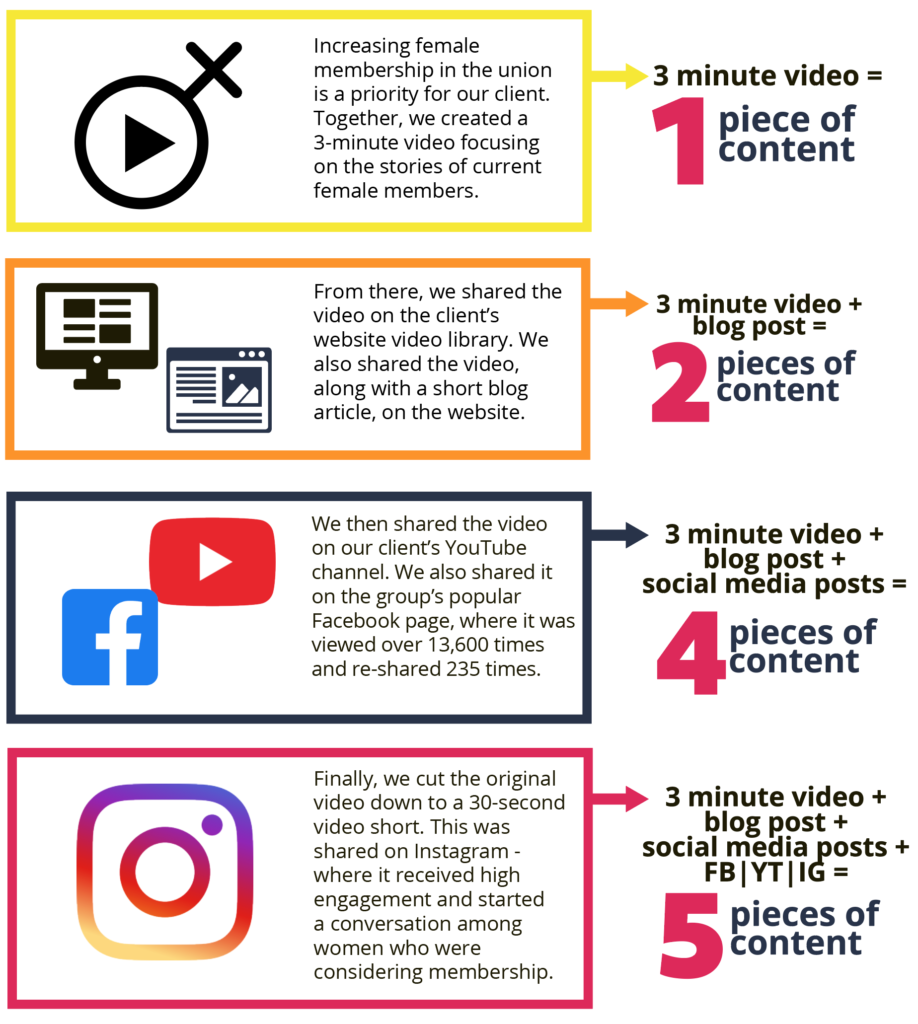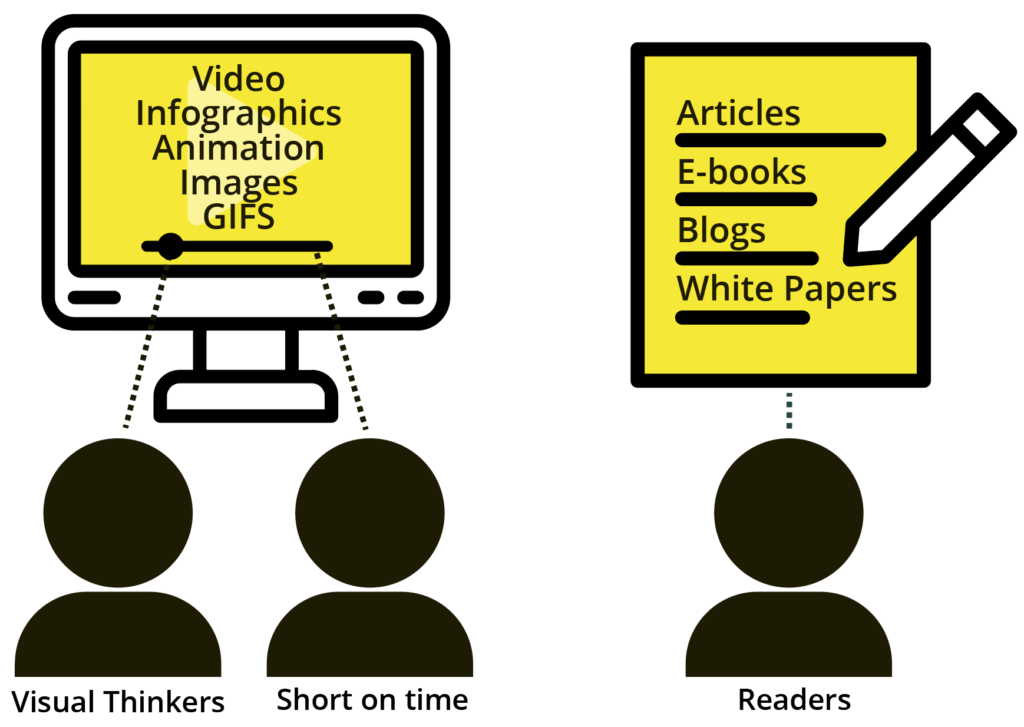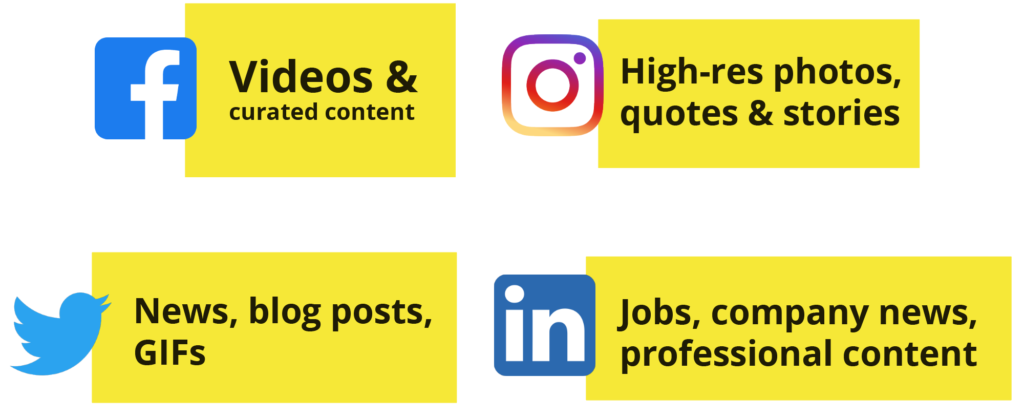Repurposing, Reusing, Rethinking:
HOW TO GET THE MOST OUT OF YOUR CONTENT
(AND BUDGET)
When the economy takes a tumble, many businesses instinctively cut back on their marketing and advertising budgets even though, historically, that’s proven a mistake. (Marketing Week)
Unfortunately, we don’t always get to control whether budgets get cut, sometimes we just need to find the best way to make those cuts work for the business. What do we do then?
Companies that put customer needs under the microscope, take a scalpel rather than a cleaver to the marketing budget, and nimbly adjust strategies, tactics, and product offerings in response to shifting demand are more likely than others to flourish both during and after a recession.
(Harvard Business REVIEW)
Creating Content that Matters
With more people at home right now, digital content is being consumed at unprecedented levels, making it a priority for businesses to create exceptional content if they want to stand out. (Visual Capitalist)
Coschedule has coined this “10x content”, which refers to “creating content that’s ten times better than anything that already exists.” (Coschedule)
But let’s just say we heed the advice above and put our content under the microscope for a moment. Is it possible to shift our thinking about how we create and manage content and, in doing so, “nimbly adjust” for shifting budgets and the changing needs of our customers?
This white paper provides context around the value of content marketing during a downturn and discusses tactics that can help you get the most out of your content, even if your marketing budget takes an unexpected hit.

The Three Stages of Content Marketing During Down Times

Stage 1: Immediate Needs
During Stage 1, your content marketing will by necessity focus on an immediate response to the downturn. At this point, many businesses hit ‘pause’ to assess content they already have to ensure it is still appropriate and useful (you know, back before things went south).
Stage 2: Reflecting on What’s Next
In the intermediate focus shifts to ‘what’s next’. Brands busy themselves understanding what’s changed for their customers and exploring new ways to address those needs. Your content marketing may also need to shift to solve new problems for customers reprioritizing where and how they spend their money.

For content marketers, it’s important to recognize how customers’ attitudes towards spending have changed in order to provide content that is valuable.
*Note: A downturn is a scary time for people. Consumers will be wary of messaging perceived as inauthentic. Building and maintaining trust is a top priority.
At this stage, it’s important to consider how you want to position your content:
This is important, as it may change just as your audience’s needs have changed.
Stage 3: The Long Haul
Once the immediate needs of customers have been addressed and you’ve taken time to reflect on what’s changed, the time is right to explore new opportunities.
Some industries may be thriving. Others may be significantly impacted.
No matter where you find yourself, remember that your content marketing should be all about providing value for your audience.
A downturn can be a fear-based time for brands just as much as it is for consumers. That makes marketing executives fearful about standing out from the crowd.
Though understandable, the end result is a lot of content that looks a lot alike. Your potential customers don’t need the same-old, same-old from you too; they need something that provides new insights, provides creative solutions to new problems, and generally helps make their lives easier.

Use Your Time Wisely
When times get tough financially, it can feel like you’re being pulled in a lot of directions at once. Maybe you have had to reduce your workforce, meaning you have fewer resources available to assist with content planning or creation. Managing your team’s time well is crucial to staying on track with your marketing efforts.
Repurposing Content
For your content marketing, repurposing content can provide a lot of additional value and help you keep your content program on track, even if you have less resources available to work with
REPURPOSING CONTENT DEFINITION:
The act of reusing content by using some or all elements of a piece of content to create additional content pieces. These new pieces of content can be used across your company’s available communication channels to extend the reach of your content without the added effort of creating brand new content.
Benefits of Repurposing Content
Repurposing content can be simple. Focus your energy on a single long-form piece of content, such as a webinar, and work back from there. By thinking about repurposing ahead of time, you can create content with this strategy in mind, making it a part of the original creative process so you’re better prepared when the time comes to break content into multiple pieces.
Here is a simple example of content repurposing we did for one of our clients, a local electrician’s trade union.

This is just one small example of how repurposing can provide added exposure and value from one “prime” piece of content.

Comparing Models for Content Repurposing
Below, we examine three popular models of content repurposing from Gary Vee, Hubspot, and the Content Marketing Institute.
Gary Vee
Gary Vee (Gary Vaynerchuk) arguably put repurposing content on the map. The Gary Vee content model is based on breaking down a piece of “pillar content” (i.e. an in depth blog article, video interview, or other piece of content) into as many as 30 individual pieces of content.
This model eschews more traditional content marketing models in that emphasis is given to quantity over professional production value. Gary recommends putting out 100 pieces of content—every day—as one of the main components of business success.
Obviously, you would be unable to put out that much material if all of it is highly produced. Gary Vee videos are often shot on the fly. Screenshots are acceptable to use as social media posts. Simplicity rules.
Context is important in this model. While content may get reshared across multiple channels, it’s adjusted to the medium at hand. This could include formatting, copy length, tone, or any other adjustments as needed based on the channel and audience.
Hubspot
Hubspot takes a deeper look at repurposing and ‘revamping’ content. This distinction is made based on your intention for the content. Revamping happens when you update a piece of content to use for its same original purpose, i.e. updating an old ebook to reflect any changes that have taken place since it was originally published. Many businesses take older blog articles and update similarly.
Repurposing is a bit different under this model, as it pertains specifically to changing the format of the content OR changing the target audience for the content.
This could include things like taking information from a webinar and turning that into an infographic to share on social media.
If you want to attract or convert more people of the same buyer persona in the same part of the buyer’s journey, a revamp is the best choice. However, if you want to attract or convert more people in a different segment, look to repurpose your content.
(Hubspot)
Under this model, the emphasis goes to targeting repurposed content to buyer personas, and to their stage in the buyer’s journey.
The buyer’s journey, according to Hubspot, includes three stages: Awareness, Consideration, and Decision. Each stage reflects the buyer’s state of mind during their purchase decision making process. Each group has its own behaviors, information needs, and preferences.
Buyer personas are different segments of buyers with their own unique needs. Based on their needs and interests, different aspects of your business will be most valuable to them and they may have their own preferred methods for consuming information.
Content Marketing Institute
The Content Marketing Institute also touts the benefits of repurposing content to get the most out of your investment.
For CMI, the focus is on meeting audiences where they are with the content they enjoy most. Attention is on whether the individual audience member is a visual learner, who may enjoy video, a reader, who prefers longer articles, or someone short on time for whom infographics can provide a succinct summary of complex information. Additional consideration is given to cross-promoting content across multiple channels.

What Approach Will You Take?
No matter which approach you decide to take, repurposed content can easily become one of your most cherished marketing activities, particularly when it is challenging to find budget and time to create new content. Repurposed content provides added value and ensures you are able to meet your target audience where they are at to educate, answer questions, and provide your unique perspective.
Previous White Paper | White Papers Home






